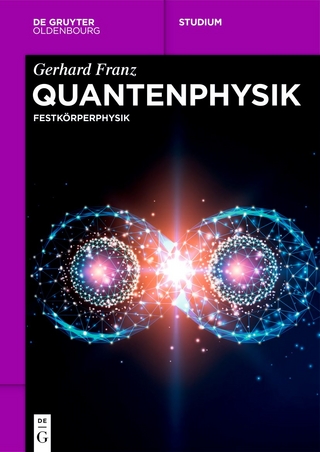
Handbook of Nanophysics
Nanoparticles and Quantum Dots
Seiten
2020
CRC Press (Verlag)
978-0-367-57712-4 (ISBN)
CRC Press (Verlag)
978-0-367-57712-4 (ISBN)
This volume provides an overview of the major categories of nanoparticles, including amorphous, magnetic, ferroelectric, and zinc oxide nanoparticles; helium nanodroplets; and silicon, tetrapod-shaped semiconductor, magnetic ion-doped semiconductor, and natural polysaccharide nanocrystals. It also describes their properties and interactions. The
In the 1990s, nanoparticles and quantum dots began to be used in optical, electronic, and biological applications. Now they are being studied for use in solid-state quantum computation, tumor imaging, and photovoltaics. Handbook of Nanophysics: Nanoparticles and Quantum Dots focuses on the fundamental physics of these nanoscale materials and structures. Each peer-reviewed chapter contains a broad-based introduction and enhances understanding of the state-of-the-art scientific content through fundamental equations and illustrations, some in color.
This volume provides an overview of the major categories of nanoparticles, including amorphous, magnetic, ferroelectric, and zinc oxide nanoparticles; helium nanodroplets; and silicon, tetrapod-shaped semiconductor, magnetic ion-doped semiconductor, and natural polysaccharide nanocrystals. It also describes their properties and interactions. In the group of chapters on nanofluids, the expert contributors discuss the stability of nanodispersions, liquid slip at the molecular scale, thermophysical properties, and heat transfer. They go on to examine the theory, self-assembly, and teleportation of quantum dots.
Nanophysics brings together multiple disciplines to determine the structural, electronic, optical, and thermal behavior of nanomaterials; electrical and thermal conductivity; the forces between nanoscale objects; and the transition between classical and quantum behavior. Facilitating communication across many disciplines, this landmark publication encourages scientists with disparate interests to collaborate on interdisciplinary projects and incorporate the theory and methodology of other areas into their work.
In the 1990s, nanoparticles and quantum dots began to be used in optical, electronic, and biological applications. Now they are being studied for use in solid-state quantum computation, tumor imaging, and photovoltaics. Handbook of Nanophysics: Nanoparticles and Quantum Dots focuses on the fundamental physics of these nanoscale materials and structures. Each peer-reviewed chapter contains a broad-based introduction and enhances understanding of the state-of-the-art scientific content through fundamental equations and illustrations, some in color.
This volume provides an overview of the major categories of nanoparticles, including amorphous, magnetic, ferroelectric, and zinc oxide nanoparticles; helium nanodroplets; and silicon, tetrapod-shaped semiconductor, magnetic ion-doped semiconductor, and natural polysaccharide nanocrystals. It also describes their properties and interactions. In the group of chapters on nanofluids, the expert contributors discuss the stability of nanodispersions, liquid slip at the molecular scale, thermophysical properties, and heat transfer. They go on to examine the theory, self-assembly, and teleportation of quantum dots.
Nanophysics brings together multiple disciplines to determine the structural, electronic, optical, and thermal behavior of nanomaterials; electrical and thermal conductivity; the forces between nanoscale objects; and the transition between classical and quantum behavior. Facilitating communication across many disciplines, this landmark publication encourages scientists with disparate interests to collaborate on interdisciplinary projects and incorporate the theory and methodology of other areas into their work.
Klaus D. Sattler is a professor of physics at the University of Hawaii-Manoa in Honolulu. A pioneer in nanophysics, Dr. Sattler built the first atomic cluster source in 1980, which became a cornerstone for nanoscience and nanotechnology. In 1994, his research group at the University of Hawaii produced the first carbon nanocones. His current research focuses on novel nanomaterials, tunneling spectroscopy of quantum dots, and solar photocatalysis with nanoparticles for the purification of water. Dr. Sattler has been a recipient of the Walter Schottky Prize from the German Physical Society
Types of Nanoparticles. Nanoparticle Properties. Nanoparticles in Contact. Nanofluids. Quantum Dots. Index.
| Erscheinungsdatum | 01.07.2020 |
|---|---|
| Reihe/Serie | Handbook of Nanophysics |
| Verlagsort | London |
| Sprache | englisch |
| Maße | 219 x 276 mm |
| Gewicht | 453 g |
| Themenwelt | Naturwissenschaften ► Biologie |
| Naturwissenschaften ► Physik / Astronomie ► Festkörperphysik | |
| Technik ► Maschinenbau | |
| Technik ► Umwelttechnik / Biotechnologie | |
| ISBN-10 | 0-367-57712-7 / 0367577127 |
| ISBN-13 | 978-0-367-57712-4 / 9780367577124 |
| Zustand | Neuware |
| Haben Sie eine Frage zum Produkt? |
Mehr entdecken
aus dem Bereich
aus dem Bereich


